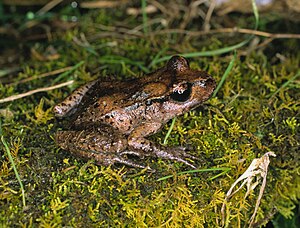Maud Island frog
| Maud Island frog | ||||||||||||
|---|---|---|---|---|---|---|---|---|---|---|---|---|

Maud Island Frog ( Leiopelma pakeka ) |
||||||||||||
| Systematics | ||||||||||||
|
||||||||||||
| Scientific name | ||||||||||||
| Leiopelma pakeka | ||||||||||||
| Bell , Daugherty & Hay , 1998 |
The Maud Island frog or Pakeka ( Leiopelma pakeka ) is a frog (Anura) from the family of the New Zealand Urfrogs (Leiopelmatidae) . It is one of the four species from the only genus Leiopelma of this primitive family living today .
The additional species pakeka comes from Te Pakeka , the name given by the Ngāti Kuia Maud Island tribe before it was given the modern Māori name Te Hoiere . Currently the westernmost point of the island is called Te Pakeka . Pakeka means land that has been depleted by cultivation, or overused land or depleted land
features
The skin is generally smooth, but there are some scattered tubercles on the trunk ( proximal ) parts of the upper and lower legs and some individuals are more warty than others. The Maud Island frogs are well camouflaged due to their brown color on the top, which varies from light brown to almost black. There are irregular dark spots or speckles on the back and face. A glandular ridge runs along the body to behind the eyes. There is no tympanum (membrane of the hearing organ), and there are no webs between the fingers and toes. The Maud Island frog is very similar to the Hamilton frog , both were previously considered one species (Bell et al. 1998). With a head-to-trunk length of 47 mm , the Maud Island frog is somewhat smaller. The species is considered monomorphic, the sexes are very difficult to distinguish. The females, as with other Leiopelma species, become somewhat larger.
Way of life
The Maud Island frog is nocturnal. It grabs its prey with its mouth, not like other frogs with the tongue of a tongue. Apart from the fact that the small egg balls with fewer than 15 large, unpigmented eggs are deposited in moist, sheltered places on the ground or under accumulations of stones, almost nothing is known about their reproductive biology. There is no free-swimming tadpole stage ; after hatching, the young climb onto the back of the male and continue their development there. During this time they are largely inactive.
Occurrence
The original range of the species is limited to the small island Maud Island belonging to New Zealand . With about 310 hectares it is the second largest island in the Marlborough Sounds , a group of islands in the Cook Strait . 1984 to 1985 another population of 100 individuals was translocated to Boat Bay. After showing signs of success, further translocations were made to Motuara Island (1997 and 2014) and Long Island (2005), both in Queen Charlotte Sound . In 2006 and 2012 attempts were made to establish another population on the main island in the Wellington region . The settlements on Motuara Island and on the main island seem successful, the success of establishing them on Long Island is still unclear.
Hazard and protection
It is estimated that only 20,000 Maud Island frogs are currently living in New Zealand. In February 2006, scientists and frog lovers began their plans to relocate the endangered Maud Island frogs to predator-free zones on the mainland. They firmly believed in the return of these rare frogs to their original ranges, although they had survived in isolation on Moad Island for many hundreds of years. In the " Karori Wildlife Sanctuary ", a nature conservation area in Wellington , 21 specimens were released according to their own information. After two years of patient waiting, 13 tadpoles hatched in February 2008, the first tadpoles to hatch in the wild on the mainland. The event was a significant milestone in expanding the range of the Maud Island frog.
Taxonomy
Before being first described in 1998 by Bell, Daugherty, and Hay, the Maud Island frog and the Hamilton frog were considered one species. In 1978 Bell saw no evidence of a differentiation between the Maud Island and Stephens Island populations; Newman found no significant differences in height or weight in 1990. Holyoake et al. saw the two species as evolutionarily significant units of the same species based on S-ribosomal RNA and cytochrome -b gene sequences in 2001 , but no taxonomic changes were made. Discussions and research on this topic are ongoing.
Individual evidence
- ↑ a b c d Ben D. Bell, Charles H. Daugherty, Jennifer M. Hay: Leiopelma pakeka, n. Sp. (Anura: Leiopelmatidae), a cryptic species of frog from Maud Island, New Zealand, and a reassessment of the conservation status of L. hamiltoni from Stephens Island. 1998 in: Journal of the Royal Society of New Zealand 28: 1, pp. 39-54. ( Online )
- ↑ a b c Leiopelma pakeka at Amphibia Web 2018, University of California, Berkeley, CA, USA.
- ↑ a b c d Leiopelma pakeka in the IUCN Red List of Threatened Species 2018-1. Listed by: IUCN SSC Amphibian Specialist Group, 2015. Retrieved September 8, 2018.
Web links
- Leiopelma pakeka inthe IUCN 2018-1 Red List of Threatened Species . Listed by: IUCN SSC Amphibian Specialist Group, 2015. Retrieved September 8, 2018.
- Leiopelma pakeka at Amphibia Web 2018, University of California, Berkeley, CA, USA.
- www.arkive.org
- www.flickr.com